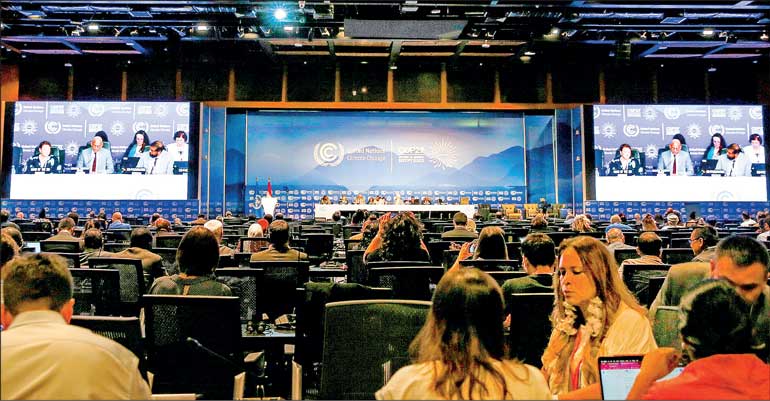Wednesday Jan 15, 2025
Wednesday Jan 15, 2025
Saturday, 3 December 2022 00:10 - - {{hitsCtrl.values.hits}}

COP27 is the world’s largest and most important climate conference and sees discussion and negotiation of a range of topics related to climate action – Pic credit UNFCCC
 COP27—the largest and most important climate conference of the year—is over, but its key topics and discussions will be carried forward throughout the year and towards COP28 on the international, regional, and national level. The outcomes of complex negotiation tracks—such as finance for loss and damage, mitigation ambition, climate finance, or Article 6 carbon markets—have attracted most of the public and media attention so far, but COP27 covers many different thematic areas related to climate change, ranging from mitigation to adaptation and from capacity-building to knowledge-sharing.
COP27—the largest and most important climate conference of the year—is over, but its key topics and discussions will be carried forward throughout the year and towards COP28 on the international, regional, and national level. The outcomes of complex negotiation tracks—such as finance for loss and damage, mitigation ambition, climate finance, or Article 6 carbon markets—have attracted most of the public and media attention so far, but COP27 covers many different thematic areas related to climate change, ranging from mitigation to adaptation and from capacity-building to knowledge-sharing.
Based on observations of discussions under these different topics, what have been the trends across 15 days of intense negotiations, dialogues, and side events? The following three thematic areas do not present an exhaustive list but highlight topics that have emerged as central to many of the conversations and discussions around the vast and winding conference venue in Sharm El Sheikh, Egypt.
Human mobility in the context of climate change
The first of these three trends was a growing emphasis on human mobility in climate spaces and discussions, including at COP27. Climate-related human mobility—which encompasses migration, disaster displacement, planned relocation, and immobile populations—is not a new topic, but one that is increasingly being acknowledged as an important consideration in policy processes. Recent research has found that in the new and updated Nationally Determined Contributions (NDCs) that countries have submitted in 2020-2022 to outline their climate actions, approximately 40% make some reference to human mobility, a marked increase to roughly 20% in the first round of NDCs.
As climate impacts become more far-ranging, frequent, and severe, they influence why, when, where, and how people move, either due to extreme weather events or long-term changes to their environment. Human mobility and climate change are deeply interlinked, and at COP27, there seemed to be recognition of this fact. It was the first COP with a dedicated pavilion for human mobility (the Climate Mobility Pavilion) as well as dozens of side events throughout the venue that highlighted thematic aspects of migration or displacement. There is a growing body of evidence on climate-related mobility that can provide further guidance on how mobility could connect to adaptation, loss and damage, or resilient livelihoods, and be addressed through the negotiations itself. Accordingly, “human mobility,” “migrants,” and “forced displacement” were all featured in the COP27 cover decision in relation to vulnerability or loss and damage.
Interlinkages between food systems and climate action
Another thematic area that has attracted discussion throughout COP27 is food system transformation. Particularly in the context of recent global events and supply chain issues, food and nutritional security have come to the forefront of debate in many countries across the world. Science has firmly established the complex interlinkages between food systems and climate change, and the need for a transition towards more sustainable, resilient, and climate-friendly food production is clear. This entails adaptation to climatic changes and management of climate risks, but also the reduction of agricultural emissions such as methane, which are a significant contributor to the causes of climate change.
COP27 was billed as an “implementation COP,” and the Egyptian Presidency put a spotlight on certain areas it considers a priority. Agriculture and food systems were one of these areas, which had been given a dedicated thematic day as well as a special initiative called FAST (Food and Agriculture for Sustainable Transformation), which focused on implementing concrete actions for enhancing climate finance contributions to transform agriculture and food systems by 2030. Furthermore, the Food and Agriculture Organisation announced that it would launch a plan within the year to make global food systems more sustainable, create a climate roadmap, and catalyse investment into companies, projects and technologies aligned with this plan.
In the halls of the conference venue, there were several dedicated food system pavilions, as well as a host of side events focusing on different aspects of food systems transformation, such as risk management and finance, water resource management, just transition, livelihood protection, reduction of agricultural emissions, agroecological and nature-positive solutions, engagement with farmers, gender in food systems, youth in food systems, or food systems and human mobility. In the cover decision, agriculture got its own dedicated section, which highlights the establishment of a four-year “Sharm el-Sheikh joint work on implementation of climate action on agriculture and food security” as well as the establishment of a thematic online portal.
Youth empowerment and action
A third important topic at COP27 was youth empowerment, which includes the recognition of youth as key stakeholders for climate action. Besides the official climate negotiations under Action for Climate Empowerment (ACE), where youth are a key stakeholder group, the 17th Conference of the Youth (COY17) also took place in the week before COP27 and gathered over one thousand young people from more than 140 countries.
Youth are key stakeholders and key actors when it comes to climate change, and it is important to amplify their voices and enhance spaces for engagement and youth-led climate action. At COP27, youth were present in the form of many youth delegates attending the conference, a thematic Youth and Future Generations Day, and the first ever Children and Youth Pavilion at a COP. Capacity-building, awareness creation, and support in finding climate-friendly and resilient livelihoods—for example, as young entrepreneurs or through greenskilling—were key topics of discussion, and many organisations were showcasing their initiatives to enhance youth engagement on the local, national, and global level.
Within and outside the main negotiation tracks, these three thematic areas will continue to be discussed in the months and years to come, as they represent important and fundamental areas where climate change will change existing ways of life. We know for a fact that change is coming, but there is still the possibility to adapt, become more resilient, transform human systems, and benefit from new opportunities.
(The writer works as Director – Research and Knowledge Management at SLYCAN Trust, a non-profit think tank based in Sri Lanka. His work focuses on climate change, adaptation, resilience, ecosystem conservation, just transition, human mobility, and a range of related issues. He holds a Master’s degree in Education from the University of Cologne, Germany and is a regular writer to several international and local media outlets.)